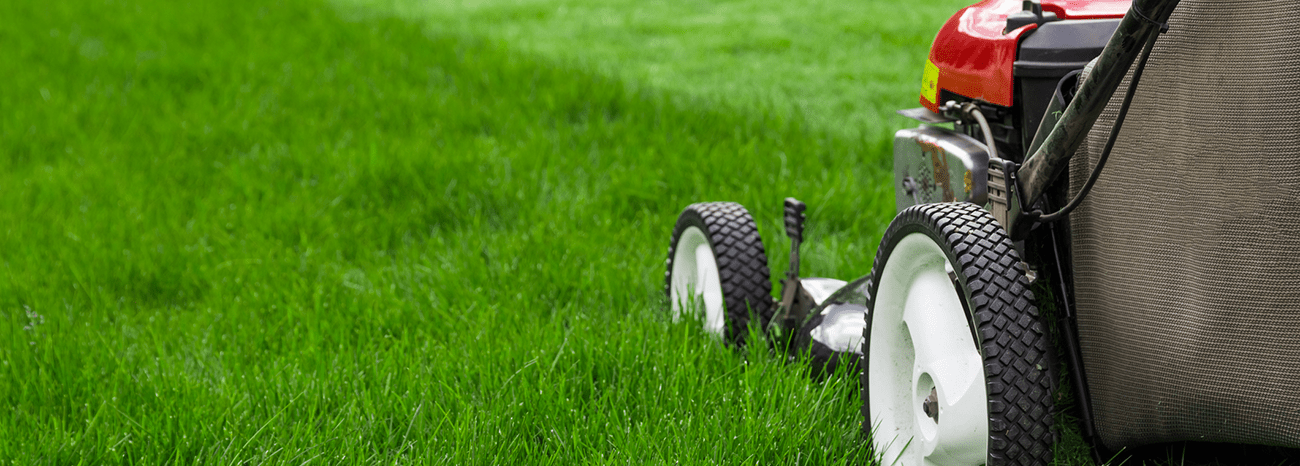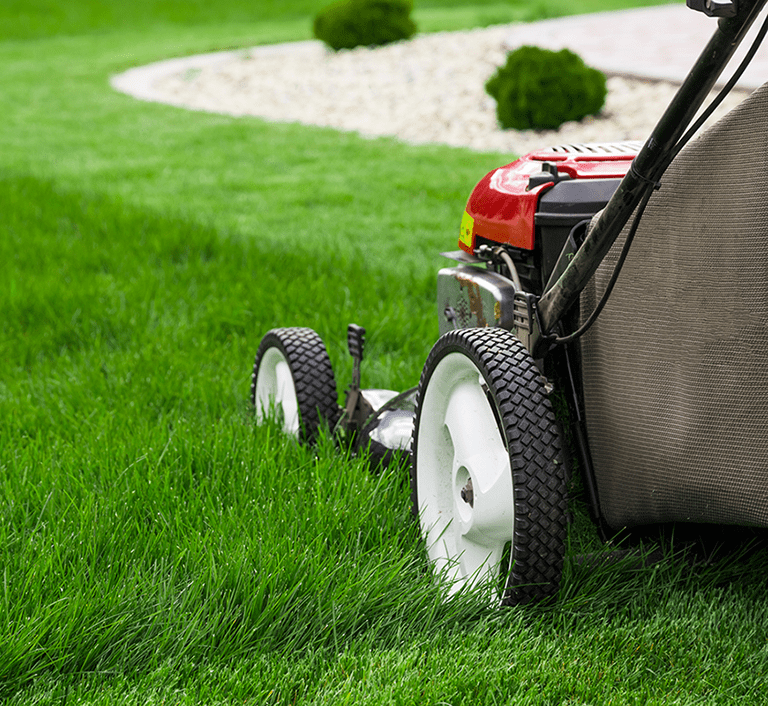How to mow a lawn might be a simple question, but improper lawn mowing techniques can take months to undo. Each cut can significantly impact the growth patterns, density, and overall health of your grass. By understanding the principles behind effective lawn mowing techniques, homeowners can transform their lawns into lush, green landscapes that are not only pleasing to the eye but also beneficial to the environment.
The way you mow, the height you choose, and the frequency of your mowing can either help your lawn thrive or put it under unnecessary stress, which can lead to a host of problems such as disease, pests, and weed invasion. In the following sections, we will explore the best practices for lawn mowing, tailored to different types of grass and seasonal conditions, ensuring your lawn remains a beautiful, healthy outdoor space for you and your family to enjoy. This guide aims to teach you how to mow a lawn using proper lawn-mowing techniques.
How to Mow a Lawn
The right type of mower for your lawn is dependent on the size of your yard. For smaller lawns, a simple push mower might be enough. This offers the added benefit of being quiet and an environmentally friendly option without the fuss and maintenance of fuel or battery-powered mowers. On the other hand, larger lawns might require the efficiency and speed of a riding mower or a self-propelled model to save time and reduce physical effort.
Additionally, it’s important to consider the mower’s cutting width and height adjustments; these features should be adjusted with the specific needs of your grass type and the contour of your land to create even, consistent cuts every time.
Preparing to Mow: A Quick Step-by-Step Guide
- Choose the Right Mower: Select a mower that suits the size and topography of your lawn. For smaller, flatter areas, a push mower might be enough. For larger or hilly areas, consider a self-propelled or riding mower.
- Check the Condition of the Mower: Before mowing, make sure your mower is in good working condition. Check the oil level, air filter, and fuel. The blades should be sharp for a clean cut. Keep in mind dull blades can damage the grass.
- Set the Mower Height: Adjust your mower height according to the grass type and season. Remember, cutting it too short can stress the grass, making it more susceptible to pests and diseases.
- Clear the Lawn: Remove any stones, sticks, toys, or other debris from the lawn to prevent accidents or damage to the mower.
- Plan Your Pattern: Decide on your mowing pattern beforehand. Alternating your mowing direction each time can help prevent ruts and even help with growth.
- Check Weather Conditions: Avoid mowing during the hottest part of the day to prevent heat stress on your lawn and yourself. Also, avoid mowing wet grass to prevent clumping and uneven cuts.
By following these easy steps, your lawn will be properly prepared for mowing and you’re one step closer to learning how to mow a lawn!
Lawn Mowing Techniques for a Healthy Lawn
The most common mistake homeowners make when mowing their lawns is that they cut their grass too short. This can result in bare spots and visible damage to the lawn. Poorly cut grass can also be more vulnerable to weeds.
If you’re mowing your lawn for the first time, understanding the height of your blades can be a bit of a trial-and-error process. If you live in an area where the grass grows the fastest during 60-75°F temperatures, you want to keep your grass between 3-3.5 inches high.
Another important tip is to think of the “One-Third Rule.” You ideally want to cut your grass to approximately one-third of your current grass height. If you cut more than half the length of your grass, it can stress it out unnecessarily. If you are an absolute beginner just getting started and not sure how to gauge this length, simply aim to have a lawn that is 3 inches in height all around and not worry too much about the different grass types. A little bit of long grass is better than grass that is too short and patchy, especially in the beginning.
Here’s a quick step-by-step guide to mowing your lawn effectively:
- Optimal Mowing Height: Adjust your mower to the ideal height for your specific grass type. For example, cool-season grasses thrive when cut to about 3-3.5 inches.
- The One-Third Rule: Always adhere to the “one-third” rule, never removing more than one-third of the grass blade length at a time to avoid stress and damage to the lawn.
- Mowing Patterns: Alternate your mowing pattern each session to prevent ruts and soil compaction. This practice also encourages upright growth and prevents grass blades from leaning in one direction.
- Blade Sharpness: Ensure your mower blades are sharp enough to make clean cuts. Dull blades tear the grass, leading to a jagged edge that can brown and increase your lawn’s vulnerability to pests and diseases.
- Mowing Frequency: Mow regularly, but adjust the frequency based on grass growth rate and the season. Typically, weekly mowing is sufficient but during peak growing seasons you may need to mow more often.
- Dealing with Obstacles: Mow around trees, garden beds and other obstacles carefully. Leave a buffer zone to prevent damage to both the mower and the obstacle and trim the remaining grass with a string trimmer for a neat finish.
- Slopes and Uneven Ground: Mow slopes horizontally and uneven ground with care to avoid scalping the lawn. Use a walk-behind mower for better control on slopes to ensure safety and an even cut.
Advanced Mowing Tips
When you’ve learned the basics and are ready to move on to more advanced lawn mowing techniques, this is the section for you. These advanced mowing tips can significantly enhance the health and appearance of your lawn. By understanding the nuances of mulching versus bagging grass clippings, addressing weeds and pests and adapting to seasonal changes, you can keep your lawn in top condition all year round.
Here are some advanced strategies to incorporate into your mowing routine for a healthier, more resilient lawn:
Mulching vs. Bagging:
Decide between mulching and bagging grass clippings based on your lawn needs.
- Mulching: Returns nutrients to the soil and maintains moisture levels. Ideal for most mowing sessions.
- Bagging: Best for controlling disease spread or when dealing with overly long grass. Ideal for excessive clippings or disease issues.
Weed and Pest Management:
- Regularly inspect for and address weeds and pests during mowing to prevent spread and unruly infestation.
Seasonal Mowing Tips:
- Spring: Cut your grass to a height of 3 inches.
- Summer: Maintain height to protect roots from heat.
- Fall: Gradually reduce height to prevent mold and diseases in winter.
- Winter: Grass is mostly dormant. However, you can mow to a height of 2 inches before the first frost to keep the lawn protected from the weather.
Mowing Challenges:
- For slopes: Mow across the slope with a walk-behind mower or up and down with a riding mower.
- For uneven ground: Raise the mower height to avoid scalping the lawn.
Adding these techniques to your mowing routine can lead to a more robust and aesthetically pleasing lawn. The goal is not just to cut the grass but to nurture a healthy outdoor environment for you and your family to enjoy.
Post-Mowing Care Tips
Proper lawn care doesn’t stop when you turn off the lawn mower. It’s crucial to follow up with appropriate post-mowing practices to make sure your lawn recovers well and continues to thrive.
Here are essential steps to take after you’ve mowed your lawn to maintain its health and vitality:
- Watering Techniques:
-
-
- Water deeply and infrequently to encourage deep root growth.
- The best time for watering is early morning to reduce evaporation and fungal growth.
-
- Fertilization:
-
-
- Apply fertilizer according to your lawn’s specific needs and the season.
- Use a balanced fertilizer that complements your soil’s nutrient profile. Need help? We can help you fertilize.
-
- Aeration and Overseeding:
-
- Aerate your lawn to improve nutrient, water and air flow to the roots.
- Overseed to fill in bare spots and improve lawn density, best done in the fall.
Implementing these post-mowing care steps can greatly improve your lawn’s health. Regular attention and care post-mowing can transform your outdoor space into a vibrant, healthy lawn that enhances your home’s overall appeal. If you want a beautiful lawn that can withstand the stresses of weather, use and pests, please contact us for more information.


